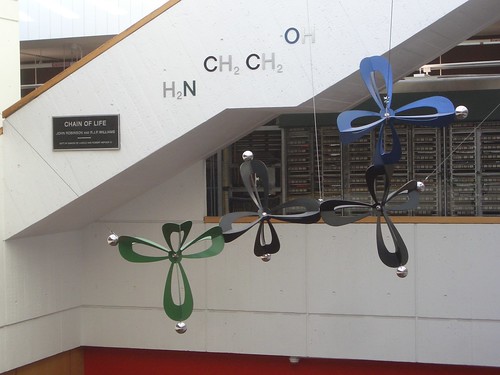The Harvard Science Center

Over President's Day Weekend, Wilhemina stopped by the Harvard Science Center in Cambridge, MA. Located on the staircase were the letters (and numbers) "H2N CH2 CH2 OH ." Next to the combination of letters and numbers was a sign, saying "Chain of Life." Turns out,
 H2N CH2 CH2 OH is the organic compound for Ethanolamine. Because it said "Chain of Life," one would think it may be an Amino Acid, but it is not. It is the second most abundant group for phosopholipids, but the reason why it says "Chain of Life" next to it, remains unclear to us.
H2N CH2 CH2 OH is the organic compound for Ethanolamine. Because it said "Chain of Life," one would think it may be an Amino Acid, but it is not. It is the second most abundant group for phosopholipids, but the reason why it says "Chain of Life" next to it, remains unclear to us.Upon further research, we discovered that ethanolamine is used to alkalize water. It's used because it doesn't accumulate in generators and spreads evenly through the steam cycle.

According to http://www.flickr.com/photos/dullhunk/323173954/ , when John Mathers at the Harvard Science Center was asked why this molecule was chosen, he simply said. ""The molecule was chosen by the artist."
When inside the building, we spotted a relatively large plant, with big leaves. the location of the plant was on the top floor, under a glass roof. Given the location of this plant, we knew it was able to grow and flourish because of the sunlight it was getting. The sun wo
 uld shine through the roof, and the plant would use it for photosynthesis. If you break down the word photosynthesis into "photo" and "synthesis," the word photo means light, and synthesis means to build. Plants need photosynthesis as an energy source. Sunlight, water, and carbon dioxide enter the chloroplasts in the plant cells, and the sunlight and water go to the Grana. This is where light reactions occur. From that, O2, NADPH, and ATP is produced. The O2 is given off by the plant. The ATP moves with CO2 to the Stoma, where the Calvin Cycle occurs. Light Independent Reactions make sugars, along with ADP+P and NADP+. The sugars created are used for energy, in which the Stoma absorbs.. Like most living things, "food" and energy help the organism to grow, like this plant. It appears to have been nourished well, with sunlight, water, and carbon dioxide.
uld shine through the roof, and the plant would use it for photosynthesis. If you break down the word photosynthesis into "photo" and "synthesis," the word photo means light, and synthesis means to build. Plants need photosynthesis as an energy source. Sunlight, water, and carbon dioxide enter the chloroplasts in the plant cells, and the sunlight and water go to the Grana. This is where light reactions occur. From that, O2, NADPH, and ATP is produced. The O2 is given off by the plant. The ATP moves with CO2 to the Stoma, where the Calvin Cycle occurs. Light Independent Reactions make sugars, along with ADP+P and NADP+. The sugars created are used for energy, in which the Stoma absorbs.. Like most living things, "food" and energy help the organism to grow, like this plant. It appears to have been nourished well, with sunlight, water, and carbon dioxide.Learn more about photosynthesis here!!!
(it's fun!)

Wilhelmina seemed to have a lot of fun learning science at Harvard University, especially spending time with her old classmates, as well as her current ones. :). In the arch of the doorway above, one was able to whisper into the wall at one end, and the other person could hear it crystal clear at the other end of the arch. Of course, the brick in the middle of the arch, holding it up, is a keystone brick- which has a similar purpose as a keystone species! It keeps the arch together, like a keystone species keeps the surrounding environment together.

XOXO,
Wilhelmina

1 Comments:
Hi,
We have just added your latest post "The Harvard Science Center" to our Directory of Science . You can check the inclusion of the post here . We are delighted to invite you to submit all your future posts to the directory and get a huge base of visitors to your website.
Warm Regards
Scienz.info Team
http://www.scienz.info
Post a Comment
Subscribe to Post Comments [Atom]
<< Home